With the holiday season are edging closer to us, the race for the promotion spots across all English leagues were also heating up day by day. In League One, many teams still stood a chance of securing the remaining two automatic promotion places since Wycombe Wanderers were running away with the top spot and the title. Two of the teams who were hoping to secure a positive result last weekend to keep their hope alive were Bristol Rovers and Peterborough United and they came up facing each other during match week 21.
Before the match, Bristol Rovers were the team who enjoyed the better form with four wins and one draw in their last five matches. This included their crucial 2-1 win over Ipswich Town that allowed them to catch up with Paul Lambert’s side and prevented them from widening the gap with the teams behind them. Their opposition in this match, though, was Peterborough, who were also chasing a promotion spot with their good form during the first stage of the season. Their recent five games in the leagues were decent, with two wins, two draws and a loss to their names. Still, Darren Ferguson’s side hoped to improve that form with three points in their trip to Bristol this time.
But, amid both teams had many shots towards each other’s goal, luck was simply not with them and eventually shared the points at the end of the day. This tactical analysis will provide an analysis of Bristol Rovers’ 0-0 draw against Peterborough. Meanwhile, using statistics, we will point out the noticeable tactical points in Kevin Maher’s tactics and Darren Ferguson’s tactics.
Lineups
For this match, Maher opted to use the team’s familiar 3-5-2 formation, the formation that did the charm for them this season. Although Mark Little and Abu Ogogo were involved in the pre-match warm-up, they didn’t make the final match squad as they continued their recoveries from their injuries. Youngster Cam Hargreaves pulled off a decent performance against Plymouth during the week but was only registered for the bench as captain Ollie Clarke completed the lineup that beat Ipswich 2-1.
The club’s top-scorer Jonson Clarke-Harris was not fit enough to start the match with him recovering from a dead leg. This allowed Tom Nichols to pair up alongside Tyler Smith to lead the line. Out wide, wing-backs Luke Leahy and Alex Rodman provided the width for the side.
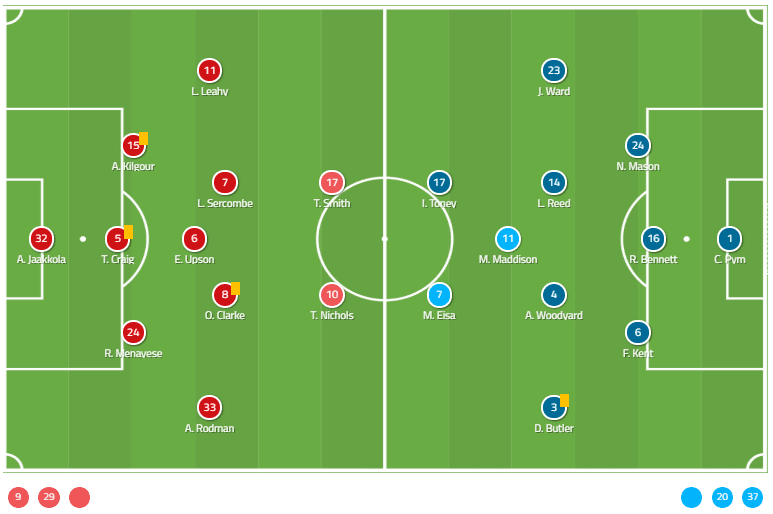
Many would expect Peterborough to line up in a 4-4-2 formation which would have seen them playing with a back-four. But Ferguson had other ideas in mind as he decided to match the opposition and used a 3-4-1-2 formation for this game. Among the names who missed out, there was club captain Mark Beevers as he was absented for the first time this season. Along with that, Leicester loanee Josh Knight was also unregistered as he could only return at the start of February.
Also absented for a similar period to Knight was Idris Kanu as he suffered from a fracturing eye socket from training. This left Ferguson with few attacking options with only two key strikers in Ivan Toney and Mo Eisa and several youngsters who were in line to step in those positions. Midfielder George Boyd and left-back Frazer Blake-Tracy could only return on Boxing Day and it meant they would also miss out from this match. To make the matters worse, Nathan Thompson was a doubt for the match with his thigh problem that forced him to leave the field just fourteen minutes into the Bolton match last Saturday.
Peterborough’s style of play
During the match, it was clear that Ferguson’s decision of lining his side up in a formation that had a back-three benefitted Peterborough significantly when they had possession. With Bristol Rovers opted to press the back-line with two strikers, the defenders had numerical superiority in the build-up phase and this helped them in playing out from the back. Usually, Niall Mason and Frankie Kent would stretch wider but still maintained a sufficient distance with Rhys Bennett to keep the passing triangle from being broken down.
Another option that Peterborough centre-backs also used was to connect with goalkeeper Christy Pym on several occasions in case it was not possible to link up with the far centre-back. This allowed them to circulate the ball in an effective way without being disrupted by the Bristol Rovers strikers.
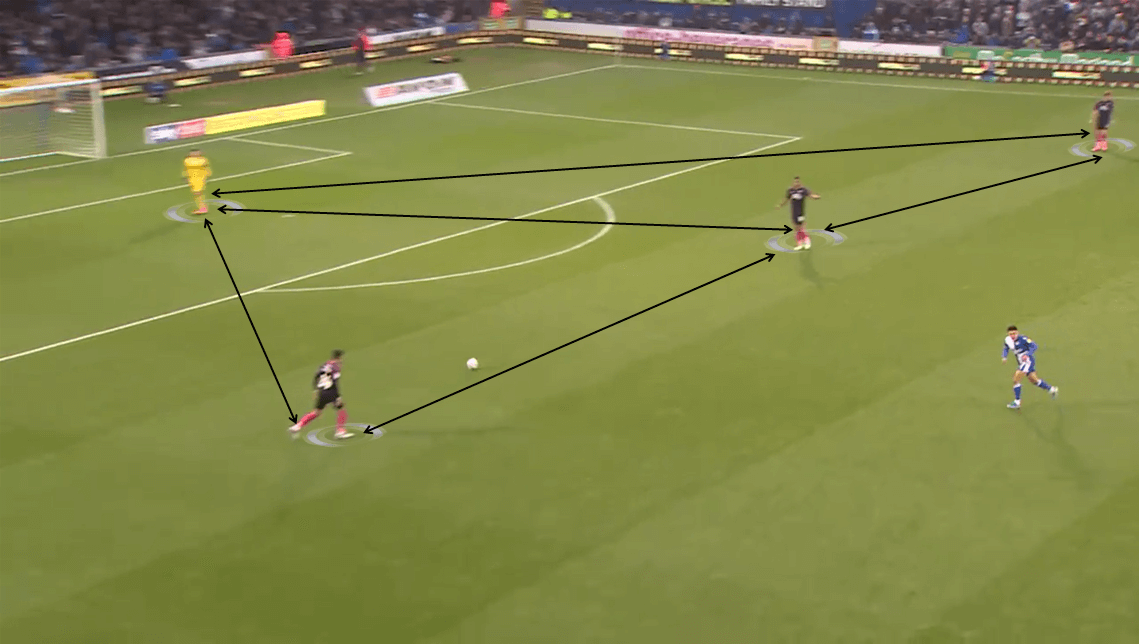
Also, they were also seen to keep the ball among themselves for quite a long time and amid the fact that this might be considered as a useless strategy, it had some intentions behind it. Firstly, this encouraged Bristol Rovers players to commit forward for the press since they didn’t have the numerical advantage during these type of situations. This created space in between the lines for Peterborough attackers to move into and also made themselves available to receive the pass from the centre-backs.
In the shot below, Louis Reed did just that as he capitalised the space between the strikers and the central midfielders to receive the pass from Kent. Although he was immediately surrounded by four players, his body orientation still allowed him to make a back pass towards Bennett or Kent and, thus, recycled possession for Peterborough. Also, the option of passing to the left-hand side for Dan Butler was also viable which could allow the team to continue progressing the ball up the pitch.
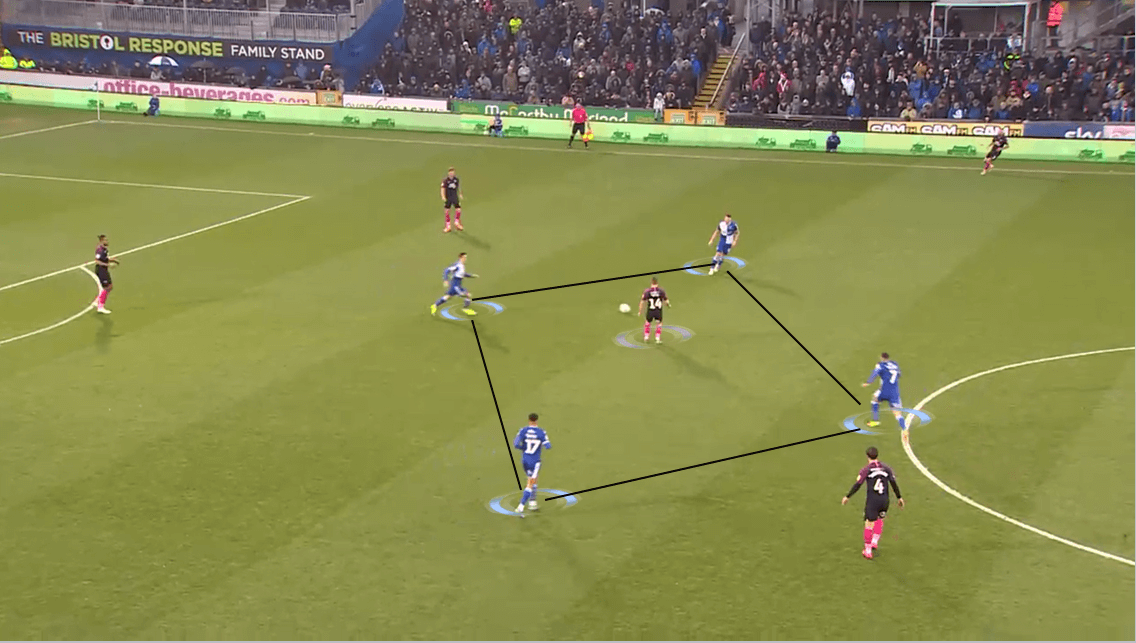
Secondly, by circulating the ball among the centre-backs, it created time for them to asset the situation and found the advanced options to play a pass towards. With Kent and Mason in their squad, they had two natural ball-playing defenders who were able to make long passes up front. As the numbers suggested, Mason was the player who committed the most long balls during the match compared to the rest of the team with eleven and completed seven of them. Meanwhile, Kent placed fourth among the squad as he registered six long passes.
But the stats also suggested something interesting to note. Placing second and third in the same aspect were wing-backs, Dan Butler and Joe Ward. They registered nine and seven long balls and completed three respectively. This showed the variety of options that could take on the responsibility of launching the ball forward during the match and it didn’t have to be put exclusively on the centre-backs themselves.
Inside the opposition’s half, Maddison tended to be the target during their offensive transitioning period as he received passes and then distributed it forward in an intelligent way. As both Louis Reed and Alex Woodyard were responsible for connecting the defenders with the team’s play, they tended to bring the ball out of defence and laid it to the feet of the attacking midfielder. It was a very usual scene at Peterborough this season with Maddison being the key during their attacks since he drove the team forward with pace and set the attackers’ in an active position to convert chances into goals.
This game was no exception as the front three continued to link up with each other and led the line for Peterborough. But Maddison was not a playmaker since he didn’t register as many passes as his teammates, whose record stood at eleven passes in this match, the second-lowest among the team without considering the substitutes. He would rather take on the opposition’s players on his own and used his dribbling ability to both bringing his teammates into play and creating chances for himself. With five out of five dribbles completed, he was the most beneficial dribbler compared to both teams’ players as he used his ability to create chances for the teammates surrounded him.
Still, with them being on the front foot for most of the times when it comes to building attacks and transitioning process, they lacked the quality needed inside the final third to turn chances into goals. While being the more superior team in xG, most of their chances all came from outside the box and it reduced the quality of the chances that they had. The time that they came the closest to score was Toney’s chance in the ninth minute as he turned up at the end of Maddison’s cross.

Defensively, Peterborough set up in a 5-3-2 formation that focused on creating a mid-block inside the middle third and their half. Both strikers didn’t move too high to press the opposition’s build-up and were happy to let them have more of the ball. Still, depended on the situation, Toney and Eisa, or Ricky Jade-Jones in the second half, would move forward and applied pressure on the ball carrier and one of the remaining centre-backs. It also relied on the fact that whether the team’s central midfielders were able to keep Bristol Rovers’ midfielders in control or not as they wanted to eliminate the prospect of one of the centre-backs made a progressive pass to the central midfielders and bypassed the first pressing lane.
Among the back-five, both wing-backs usually drifted wide and occupied both flanks as they aimed to follow Leahy and Rodman. Meanwhile, the central area was overloaded by the centre-backs and the central midfielders since they prevented the opposition from creating attacks through the central half. But that intention didn’t prove to be successful as the home side still registered sixteen chances centrally and even reached the xG rating of 0.37.
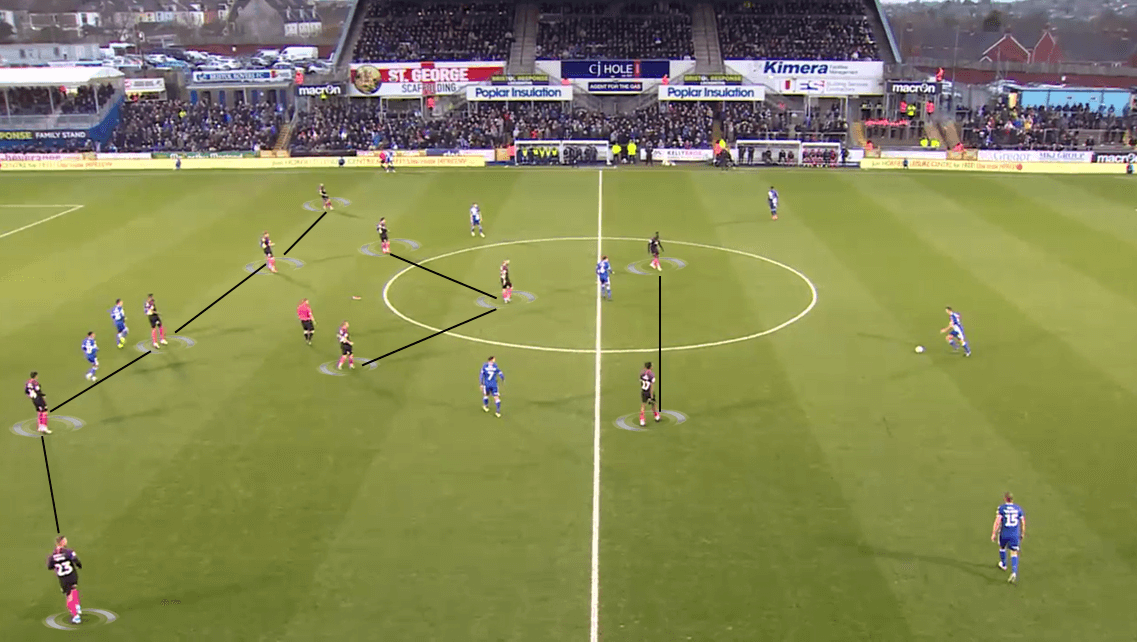
Bristol Rovers’ style of play
Throughout this season, it became a familiar scene to see Bristol Rovers lined up in a 3-5-2 formation as almost half of the time they opted to choose an attacking version of this formation or a defensive one in a 5-3-2. Still, that relied on the attacking force of the opposition and it could be rotated flexibly during the match and in different transitioning situations.
This match was not an exception, either, as caretaker manager Maher used a familiar formation to avoid the necessity of adapting to a new style of play. The aim of this formation was to create a defensive juggernaut inside their half and gained numerical advantage during defensive situations. This was also one of the reasons that caused Peterborough a struggling day in front of goal since the attackers didn’t have too many opportunities to progress the ball into the final third.
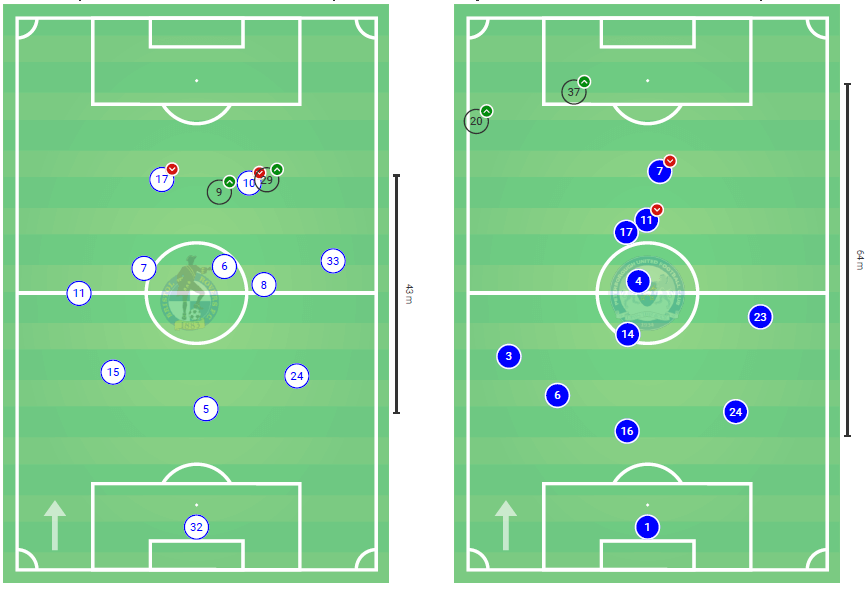
With a mid-block of eight created just on the edge of the middle third, Bristol Rovers were able to take control in most defensive situations and intercepted smart passes being made towards their 16-yard box. Also, as Peterborough’s average formation focused on keeping things narrowed and inside the central half, Bristol Rovers also had more players inside the central half to track the run of the advanced players and prevented them from attack the final third.
As mentioned, Bristol Rovers also aimed to press high on several occasions and it was important to be disciplined in keeping the defensive positions. If one slight movement was made and it was mistimed, that player would leave space for Peterborough attackers to enter and turn up at the end of passes. At the same time, the team pushed their defensive shape higher up the pitch and allowed the midfield line to provide support for Nichols and Smith in their press.
This was when Peterborough usually caught Bristol Rovers asleep as their attackers used pace to beat the defenders and dribbled the ball into the final third. Kent and Mason would make long balls towards the opposition half while aiming for Toney and Eisa. It allowed them to sit on the shoulder of defenders and broke through using flexible movements and through passes.
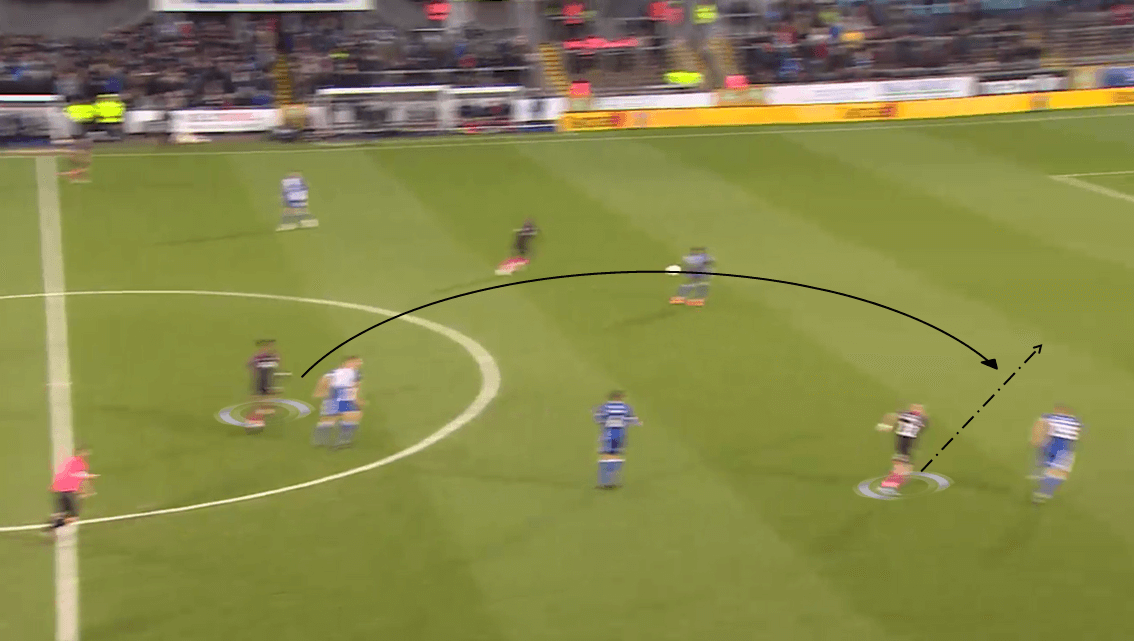
Another thing worth noticing about Bristol Rovers’ defensive juggernaut is that they kept their distance between the defensive lines as narrow as possible. Especially in front of goal, the players aimed to defend zone 14 and the 16-yard box by having five defenders sticking to their positions and stopped long shots from reaching Anssi Jaakkola’s goal.
They received support from the central midfielders, who took on the responsibility of screening the space in front of the defensive line. It was possible for them to move flexibly inside the defensive third to mark the ball carrier and his possible passing options while intercepting through balls that were made.
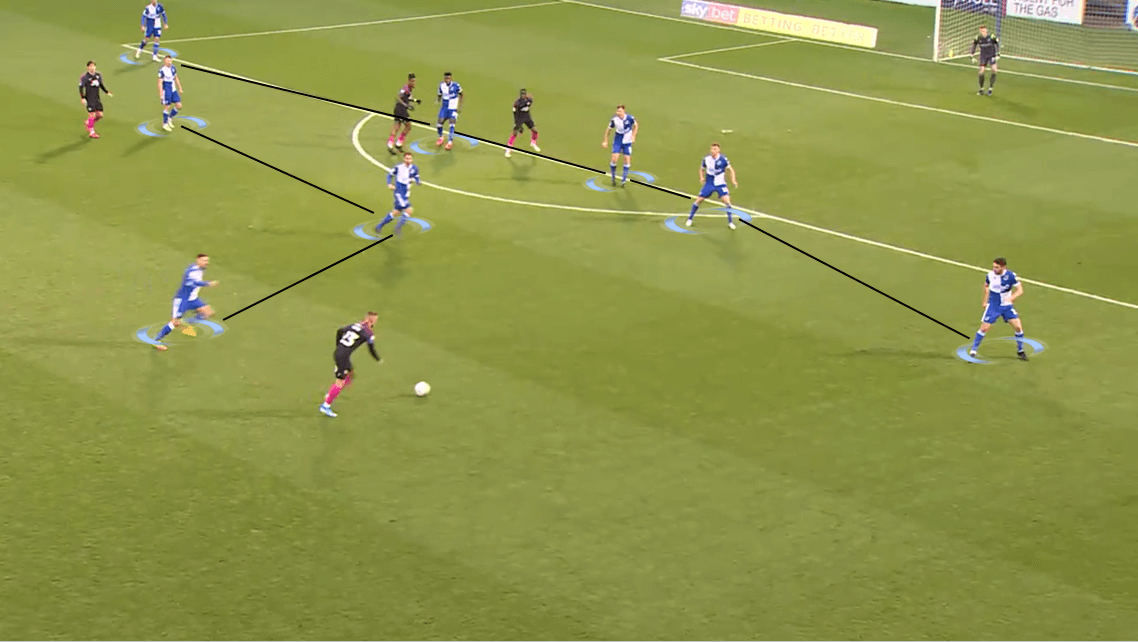
Offensively, they were not much better compared to Peterborough and some might see them doing worse than the visitor considering the number of shots. In total, they registered eighteen shots and again, most of them came outside of the box. Amid the two chances by Ed Upson and Ollie Clarke in the 55th and 56th minute, they saw a number of those chances being blocked or went wide.
With the urgency of finding the winning goal inside the second half, it was understandable to see Bristol Rovers registered more chances compared to their record during the first period. They also reached a significantly higher xG rating with 0.75, with most of them came from Upson and substitute Clarke-Harris. Amid the fact that they weren’t able to score in the match, there was a slight improvement being made in terms of creating chances and showed they were not willing to be on the back foot for the majority of the time.
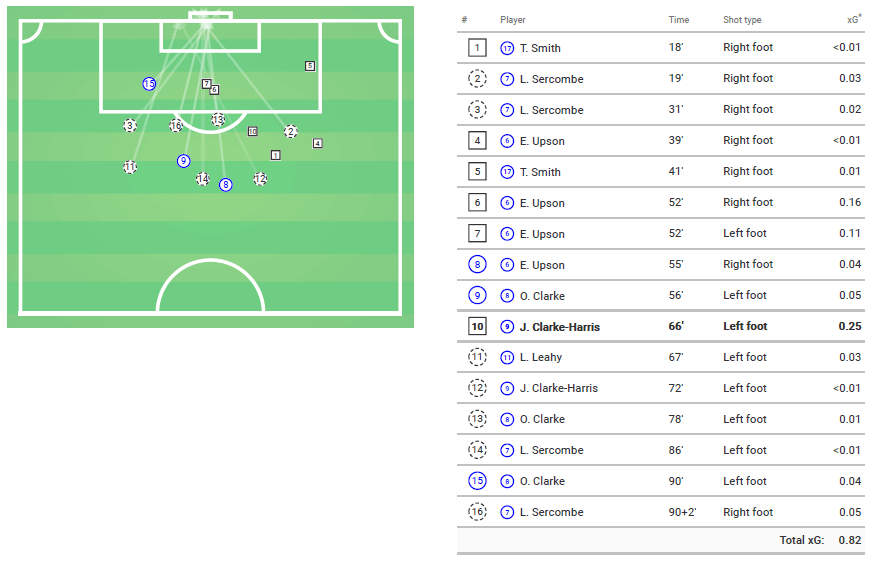
One of the methods that Bristol Rovers opted to go with in order to progress the ball into the box was to use lofted passes. Similar to how the home side defended, Peterborough also narrowed the distance between their defensive lines and aimed to defend zone 14 more often. To bypass Peterborough’s defensive shape, the central midfielders tended to use lofted balls into the box for Nichols and Smith and capitalised their aerial ability to win headers.
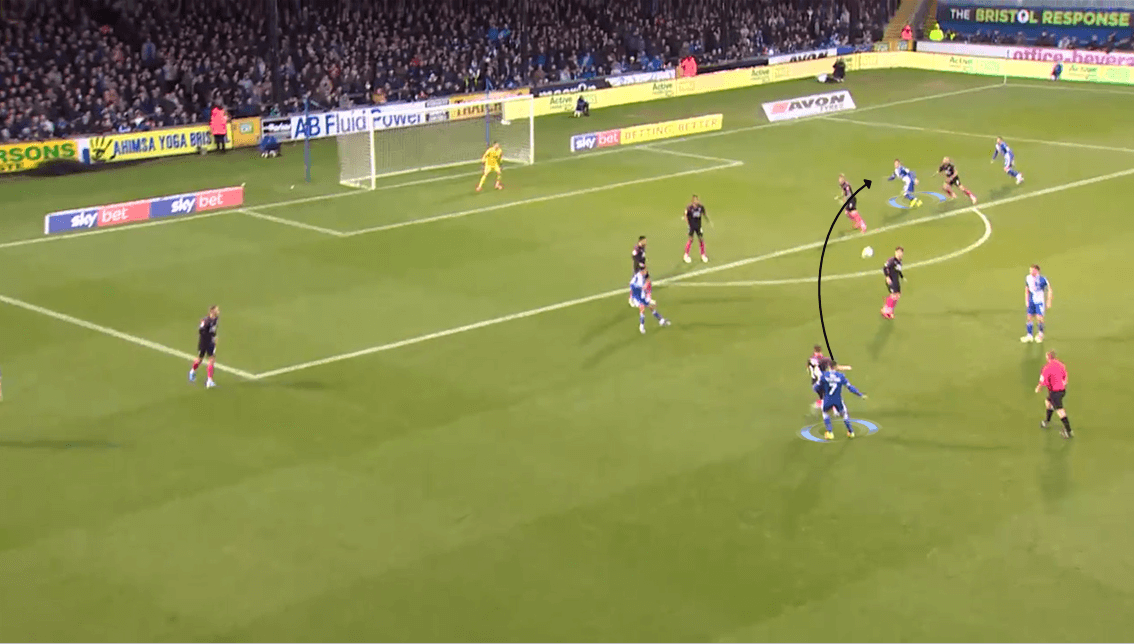
Conclusion
At the end of the day, there was nothing separated the two sides who were chasing for an automatic spot and this increased the intensity of the race with most of the sides below Bristol Rovers and Peterborough came out with a positive result. Against a team whose mentality tended to focus on defending, Peterborough’s attacking trio found its hard to get themselves into the box and looked for a good position to score. They now have to settle for a point and with Boxing Day coming up, they are hoping to improve on this result to keep their hope of promotion alive.
Considering the state that Bristol Rovers are in with no manager managing the team, one point can be considered as a decent result in the race to a play-off spot. With Ben Garner now being appointed as the first-team manager, the team are hoping that he will inherit the style of play that Graham Coughlan left behind with the hope of gaining an automatic promotion spot at the end of the season.

If you love tactical analysis, then you’ll love the digital magazines from totalfootballanalysis.com – a guaranteed 100+ pages of pure tactical analysis covering topics from the Premier League, Serie A, La Liga, Bundesliga and many, many more. Buy your copy of the December issue for just ₤4.99 here





Comments